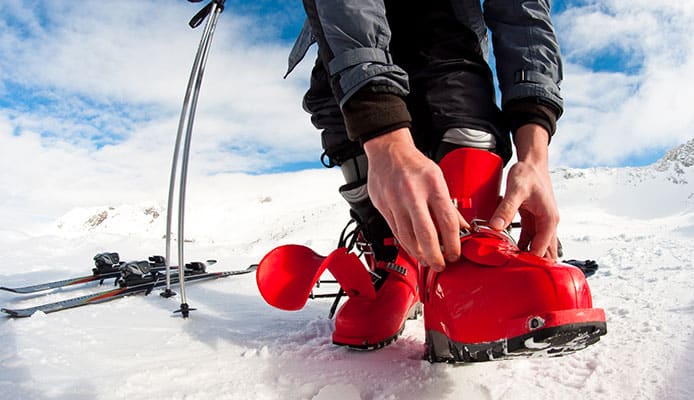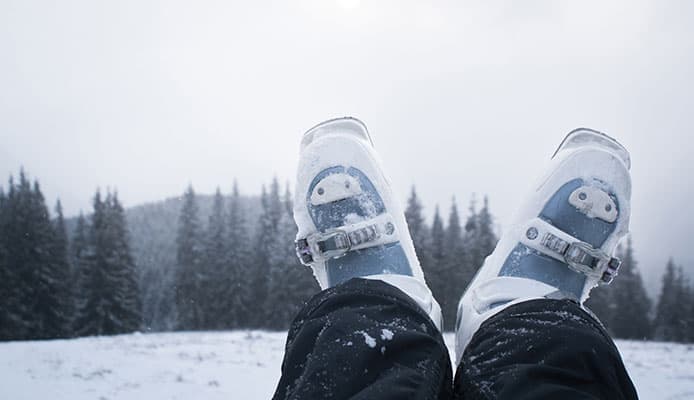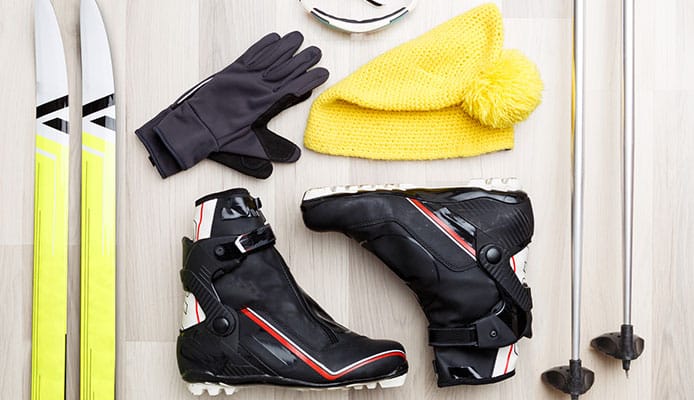
-
1.
-
2.
-
3.
-
4.
-
5.
There’s a lot of gear involved in skiing and you need a way to transport it properly. Boots for skiing, in particular, can pose a challenge if you don’t have the right bag since they shouldn’t be bent or crushed during storage or transport. This problem can be easily remedied by investing in the best ski boot bag. Naturally, you’ll want that bag to last a while and deliver quality. Below, we’re going to take a look at the 10 best ski boot bags in 2023 to help you find the best bag for ski boots that fits your needs.
OUR TOP PICK
Athalon Everything Ski Boot Bag
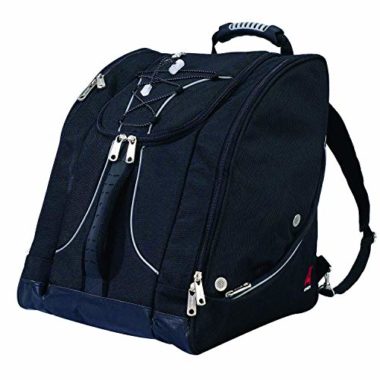
- What Makes This Stand Out
- Plenty of storage with a large center section, ventilated side pockets, and an MP3 pocket
- Internal clips inside the pockets to hold small supplies in place
- Large enough for skiing boots up to size men’s 13
- Padded straps and lumbar pads for comfort
- Waterproof bottom and drainage grommets to prevent
- Reflective piping for higher visibility in dark conditions
- 5-year warranty protects you from any premature wear and tear
- Available in multiple colors and patterns
- Easy to carry
Dimensions: 17” x 15” x 14”
Denier: 600D
Weight: 2.25 lbs
Shoe size: Up to men’s size 13 boots
Material: Polyester
EDITORS CHOICE
Transpack Edge Isosceles Ski Boot Bag
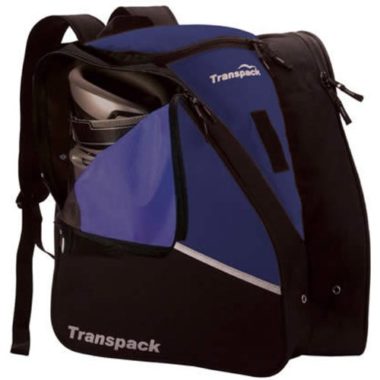
- What Makes This Stand Out
- Large enough for skiing boots up to men’s size 13
- Good investment for advanced skiers looking for a durable, long-lasting bag
- Self-repairing nylon coil zippers ensure the zippers don’t break or get stuck
- Side pockets with drainage grommets
- Water resistant main pocket for boots
- Neoprene padded shoulder straps for easy, comfortable carrying
- Available in multiple colors
Dimensions: 15” x 18” x 17”
Denier: 600D
Weight: 2.1 lbs
Shoe size: Up to men’s size 13 boots
Material: Polyester
BEST VALUE
High Sierra Lightweight Ski Boot Bag
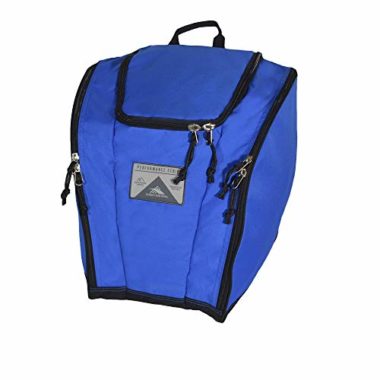
- What Makes This Stand Out
- Large enough for skiing boots up to men’s size 13
- Two zippered external pockets featuring drainage and ventilation grommets
- Adjustable shoulder straps
- Grab handle with webbing on top of the bag
- Lightweight at on 0.26 pounds
- Available in multiple colors and patterns
Dimensions: 16” x 16” x 13.5”
Denier: 400D with 840D nylon
Weight: 0.62 lbs
Shoe size: Up to men’s size 13 boots
Material: Polyester and nylon
Athletico Ski Boot Bag
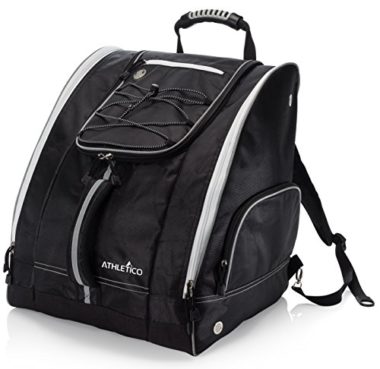
- What Makes This Stand Out
- Plenty of storage with a side-zipper storage pocket and a spacious main pocket
- Internal clips inside the pockets to hold small supplies in place
- Large enough for skiing boots up to men’s size 13
- Additional storage with bungee-cords on the front of the bag
- Removable padded shoulder straps, padded lumbar support, a padded top handle, and a padded front handle
- Ventilation discs to help with moisture retention on the bottom and sides
- Reflective piping for higher visibility in dark conditions
- Metal hardware will last years
- High denier means the polyester material is strong
- Easy to carry
Dimensions: 3.5” x 10” x 15.5”
Denier: 1200D
Weight: 2.4 lbs
Shoe size: Up to men’s size 13 boots
Material: Polyester
Element Equipment Ski Boot Bag
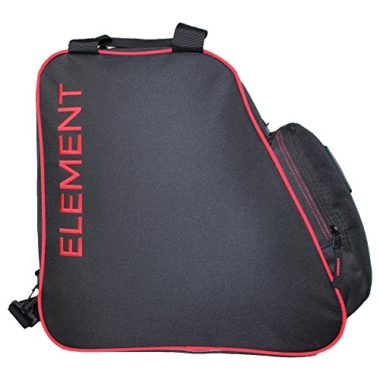
- What Makes This Stand Out
- PVC coated polyester is waterproof and 3 vent holes help to keep everything clean and dry
- Large enough for skiing boots up to men’s size 13
- Durable thanks to reinforced stitching, a lined interior, and padded bottom
- Shoulder strap and carrying handles offer versatility in how you’re comfortable holding the bag
- Available in multiple colors and patterns
- Comes with a 100% satisfaction guarantee
Dimensions: 15” x 15” x 19”
Denier: 600D
Weight: 1.5 lbs
Shoe size: Up to men’s size 13 boots
Material: PVC coated polyester
Element Equipment Ski Boot Bag
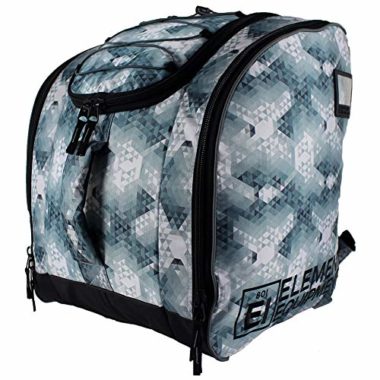
- What Makes This Stand Out
- Large enough for up to men’s size 14 boots
- Separate goggle fleece-lined pocket to prevent scratches
- Reinforced double stitching and lined interior strengthens durability
- The padded bottom helps the bag keep its shape
- Oxford PVC coated polyester helps to keep water out
- Available in multiple colors and patterns
- Comes with a 100% satisfaction guarantee
Dimensions: 17” x 15” x 15”
Denier: 600D
Weight: 2.8 lbs
Shoe size: Up to men’s size 14 boots
Material: Oxford PVC coated polyester
Transpack XT1 Ski Boot Bag
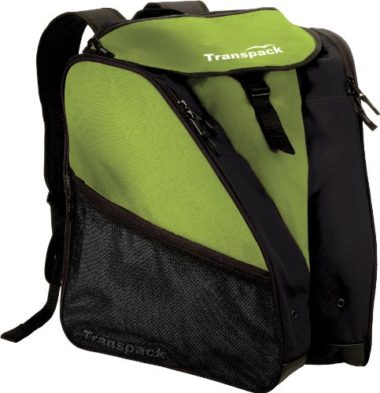
- What Makes This Stand Out
- Plenty of storage with a boot pocket, internal pockets, and pockets on the side
- Since all the pockets are zippered, it makes organization a breeze
- Large enough for men’s size 13 ski boots and large helmet
- Foam padded back and neoprene padded shoulder straps for comfort
- Self-repairing zippers help durability
- Coated for water resistance
- Available in multiple colors and patterns
- The 1-year warranty covers any initial problems you may run into
Dimensions: 18” x 17” x 15”
Denier: 600D
Weight: 2.7 lbs
Shoe size: Up to men’s size 13
Material: Polyester
OutdoorMaster Ski Boot Bag
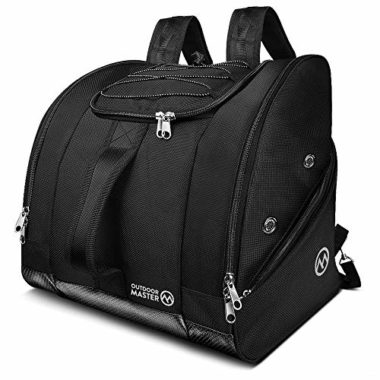
- What Makes This Stand Out
- Large bag with two separate boot compartments meant for all shoe sizes
- External compression cords offer extra storage potential
- Drainage holes and ventilation grommets help water drain and reduce stinky shoe smell
- Wet/dry separation pocket to keep gear in order coming back from the slopes
- Can be easily carried with a pair of ergonomic carrying handles or adjustable shoulder straps
- Available in multiple colors and patterns
- Backed by a lifetime warranty
Dimensions: 16.92” x 13.78” x 9.1”
Denier: 900D
Weight: 2.4 lbs
Shoe size: Made to fit all sizes
Material: Nylon
Athletico Weekend Ski Boot Bag
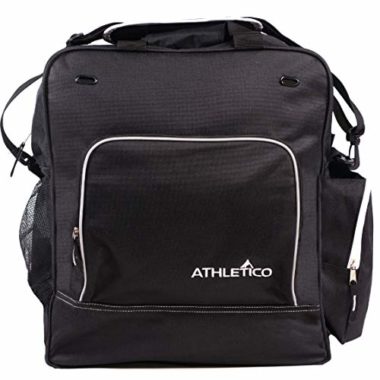
- What Makes This Stand Out
- Large enough for all your skiing gear from boots to helmets to gloves, scarves, and more
- Storage added by the zippered and mesh pockets on the sides
- Tote handles and a padded cross-body shoulder strap give comfortable carrying options
- Water resistant polyester helps to keep your gear dry
- Grommets help drainage and to let in fresh air
- 100% satisfaction guarantee protects your purchase
- Large boot compartment
Dimensions: 17” x 17” x 9.5”
Denier: 600D
Weight: 1.8 lbs
Shoe size: Large enough for all shoe sizes
Material: Polyester
High Sierra Deluxe Trapezoid Ski Boot Bag
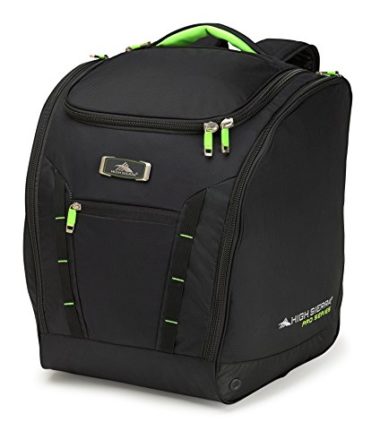
- What Makes This Stand Out
- Large main pocket to carry all your gear including helmets alongside boots
- Mesh pocket inside to store boots and helmet separately
- Zippered pockets on top of the lid and on the side hold smaller gear like goggles
- Large enough for up to men’s size 13 boots
- Padded foam shoulder straps and ergonomic carrying handle for easy, comfortable carrying
- Ventilation to help water drain and prevent stinky shoe smell
- Large boot compartment
Denier: 840D
Weight: 1.2 lbs
Shoe size: Up to men’s size 13
Material: Nylon
How To Choose A Ski Boot Bag – Buying Guide
Material
Material means a lot when it comes to choosing the most efficient ski boot bag. It can also work as a protective layer for the bag to protect the contents inside. This reduces how wet the contents inside get which is important for small struggles like a damp neck warmer when you need it. It also protects the contents of a bag that can be damaged by excessive moisture.
This means you won’t want a fabric that’s thin or flimsy. The best and most common choices are polyester or other synthetic fabrics.
Alongside the type of material, you can choose the color of the material as well. Once upon a time, almost all ski boot bags were a standard black but you can get a wider range of styles and patterns anymore.
Size
This is perhaps one of the most important features to consider when looking for a ski boot bag. If you buy a bag that isn’t big enough for your ski boot size, you’re aren’t going to be able to use that bag to carry your gear. From an opposing view, if you get a large bag when you don’t need one, you might find that it’s a little bulky. Yet, when given the choice, it’s a good idea to be safe and go for a larger bag than you need rather than a smaller one. That way, you know you’ll have enough room to store your gear.
There are a few ways to determine the size of a bag when you’re shopping online. Dimension measurements are one way to gauge how much room you’ll have. What puts the size of the bag into an easier perspective for most is the highest ski boot size the bag is recommended for. Most ski boot packs are made to accommodate almost all ski boot sizes but it’s still a good idea to check. You might also want to look for a smaller size if you’re looking for a carry on bag.
Quality
Quality is an essential factor in choosing the most efficient ski boot bags. Obviously, you aren’t going to get a low-quality option because no one prefers to make an investment that isn’t going to pay off in the long run. With that concept in mind, quality is often directly linked to cost and there are different levels of quality for different skier’s needs.
A professional or frequent skier is going to want to invest in a high-quality option. This is because if they get a low or standard quality option, there’s the potential that they will run through bags faster. In the long run, frequent replacements are going to come at a higher cost over time than a one-time investment that’s going to last you years.
In this comparison, it doesn’t mean that beginners and casual skiers should buy low-quality ski boot bags. They just might not need top-of-the-line options that come at a high cost. Luckily, there are high-quality options – included many of the options we looked at earlier – that are budget-breaking for skiers that aren’t looking for or need to spend a lot of money on something they’ll only use from time-to-time.
Generally, quality is definitely something to look out for. It’s also important to make the distinction between price and quality. There are plenty of low-cost options that will last you years to come.
Waterproof
Investing in a waterproof bag is going to go a long way in protecting your gear. Boots for skiing, the clothes inside, and even ski boot bags themselves can suffer from being left wet between ski outings or during the offseason. On top of that, you’re going to be frustrated if you pull out an extra balaclava just to find it soaking wet. To be fair, though, the freezing temperatures do help keep things dry as well but waterproof features are still worth considering. Waterproof bags include waterproof fabrics and/or water-resistant zippers.
On the topic of dealing with water in your bag, you’ll also want to look at ski boot bags with vents and drains. These are specifically geared toward dealing with water already in the bag. For example, if you had to toss your wet boots into your bag on the way back from the slopes, these features will allow the water in the bag to drain out and offers fresh air in the bag. There are a few answers about how ventilated backpacks work. Namely, you’ll see that this helps to reduce the smell that can follow wet, worn shoes in a completely closed off bag.
Handle
The handle of your bag makes it easier to carry when you aren’t carrying it on your shoulder. Much like shoulder straps, you’re going to want something that’s comfortable to hold. This could include an ergonomic hard handle which is more common on a wheeled bag rather than a backpack-style pack. For the latter, the handle is typically padded like the shoulder straps.
Type
Most ski boot bags – like the ones we’ve looked at in this review – are soft-shelled. They’re made to protect your boots and other gear without being too bulky. Most bag types are larger near the straps and narrow out near the front of the bag. These ski boot bags are described as trapezoid bags.
There are a few different options with the straps. You can purchase ski boot bags with a single shoulder strap, double shoulder straps, chest straps, waist straps, and even a wheeled ski boot backpack option. This is something that comes down to preference more than natural superiority.
Construction
We already looked at the types of fabrics that will make for the most durable bag: polyester and other synthetic options. How that fabric and the bag is constructed is just as important to consider.
Mainly, you’ll want to pay attention to the density of the fabric. This is referred to as denier and the higher the number is the better it is. Lower numbers refer to loosely woven cloth and you’ll want to look for tightly woven cloth for the most efficient ski boot bag. The standard denier for a backpack sits at around 600 but a bag should be tougher than that around 1050. The strongest denier is sometimes labeled as “ballistic.”
Comfort
Comfort means a lot in any product you buy including ski boot packs. A top-rated bag for skis shouldn’t be a pain to lug around. What is comfortable for you can vary from person to person but there are some aspects to consider when choosing what works for you.
First, padded straps are going to make life much easier. These will prevent the straps from digging into your shoulders. Some packs have padding on positioned to make the pack more comfortable on your back as well as your shoulders. It’s worth pointing out that some skiers find it easier to use straps that aren’t padded for carry-ons and packing up for long car trips to the slopes.
Another feature is how comfortable it will fit on your back. This is where online shopping might be seen as a disadvantage since you can’t try the backpack on before buying. A way around this is to look at the reviews that other users have left. They’ll delve into the details that the advertised features might not. That’s why we included honest customer opinions in our ski boot bag review.
Compartments and Pockets
While the goal of ski boot bags is to carry your boots, most go the extra mile but offering storage for other gear. First, let’s look at the main compartment. The section of the bag for boots is usually one large compartment for your boots. Some ski boot packs have this compartment split into two so the boots are separated from one another.
There are also often initial compartments inside the bag for gear like goggles. This helps to keep everything organized and in top shape.
Some ski boots backpacks also have external pockets for extra storage. These are usually smaller pockets just similar to the extra zippered compartments you’d expect from an average backpack. Instead of being big enough for most gear, these are meant for smaller items such as gloves and balaclavas. Some packs also have external shock cord lashing to add extra external storage.
Zippers
The quality of the zipper on your bag is just as important as the quality of the bag itself. There’s nothing quite as frustrating as getting ready to put your gear away for the day only for the zipper to snap off your bag. Because of this, it’s a good idea to look for ski boot bags with metal zippers instead of flimsier plastic zippers. Small zippers are also more likely to break than larger ones. We already covered waterproof zippers which prevent water from leaking through the seal.
You can protect your zippers for longer by avoiding overstuffing your bag. If you need more room, it’s better to just invest in a large bag.
Additional Features
One additional feature of more high-end ski boot bags is heating. This can be used to warm your boots before you hit the slopes or to help them dry after a trip. They work by plugging the bag in and many work with a car’s 12V plug. Direct heat isn’t the best for boots so many of these ski boot bags have an extra protective layer to keep them safe. You can find ski boot bags with multiple heat settings. Any heated bag should have some sort of draining or ventilation system since the heat will melt any residual snow on your gear.
FAQs
Q: What Is a Ski Boot Bag?
A ski boot bag is a bag that is made specifically for carrying ski gear. Don’t be fooled by its name either – they can carry more than just boots. Many of them have pockets and compartments to carry other gear. There are plenty of styles of ski boot bags to choose from too. You can choose a heated bag, a wheeled bag, or a large one. They are also sold with different budgets and skill levels in mind. For instance, an expensive bag made with premium materials suits a professional or frequent, highly-skilled skier. On the other hand, those types of bags might not be the best ski boot bag for a recreational or beginner skier who doesn’t need a heavy-duty choice or aren’t ready to make a high-cost investment.
Q: Why Buy a Ski Boot Bag?
While a standard backpack might work for carrying certain gear, it would be difficult to carry everything you need for skiing without a bag made to carry gear like ski boots. However, they aren’t limited to only storing ski boots. The ski boot bag will have room for other gear such as goggles and gloves which will give you a compact, central place to store your gear. This is especially important during travel. All in all, choosing a quality ski boot backpack is going to make transporting your gear much easier.
Q: Can I Take a Ski Boot Bag On a Flight?
First and foremost, it’s important to note that different airlines can have slightly different rules for bags and carry-ons. For example, the requirements of a soft ski boot packs vs. a hardshell case can vary from airline to airline. That being said, we’re going to answer the question generally.
First, let’s consider the cost. This is another varying factor depending on if the bag is a carry on ski boot bag or a checked bag. If it’s the latter, the exact cost can vary based on the company and any rewards you might have with them. You’ll also need your ski boot bag to weigh less than 50 pounds which, for most skiing equipment you’d keep in a boot bag, shouldn’t be a problem. If you aren’t sure how much your bag weighs, a simple bathroom scale can give you an idea.
The biggest combatant to airline travel is that ski boot bags can be large to be a carry on in size rather than weight. While they probably won’t fit at your feet, you’ll probably be able to store them in the overhead bin with no problem. Again, it’s a good idea to look at the specifics that the airline your using has for carry-ons.
Most airlines don’t charge the same oversize fees for equipment such as skis and snowboards. It’s a good idea to get to the airport early and check with the airline you’re using beforehand to handle any complications with checking your gear. This goes double if you’re traveling internationally. This has more to deal with dealing with security checks rather than checking ski boot bags.
Q: How to Clean and Store a Ski Bag?
At the end of the season or in stretches between trips to the slopes, it’s important to clean and store your ski bag properly. Of course, you can bring your gear into a shop for tune-ups, and while this is a good idea for skis themselves, you can wash your bag on your own.
Most manufacturers have their own, specific guidelines for cleaning their ski boot bags. For completely soft bags, you might be able to wash the bag just like you wash other fabric gear. However, a safe bet for either completely soft for partially soft bags is to hand wash off any mess.
The biggest part of taking care of your ski bag is making sure you don’t put it away wet. So, you’ll want to let it sit out to dry much longer than you might think necessary to let it dry out completely. Don’t use a heater or dryer to dry it out because high temperatures can damage the bag. It can also help to use durable water repellent – or, DWR – on your bag and clothes before the season starts. This will help water roll off this type of gear in beads rather than soaking in.
As for storage, you’re going to treat ski boot bags much like your outerwear. First, make sure to check for any damage such as a broken zipper or tears. If this damage is significant, you might need to update your bag. Fortunately, a quality ski bag is going to last you years of frequent use before this is a problem. If anything does happen to your ski bag early on, many manufacturers and sellers offer some type of warranty.
Then, you’ll want to store your bag out of the sun to protect the color of the fabric. You’ll also want to avoid any areas that are too damp or even too dry such as garages, attics, or unfinished basements. Environments that are too hot are likely to damage your bag as well, so it’s good to keep them somewhere where you can control the temperature. The best place to keep your bag is in an indoor closet or under your bed.
Q: During the Summer, Should I Store My Boots In the Bag or Separately?
Once you’ve cleaned and dried everything, there isn’t necessarily a reason to store boots and bags separately. After all, It can even be a way to save space. But, you’ll want to be careful not to place anything on top of the bag especially anything with substantial weight. Making sure that ski boots keep their shape is incredibly important.
You also won’t want to leave the ski boots in the bag on a trip and throw the bag straight into the closet. Your ski boots need maintenance just like any other piece of gear. You’ll want to make sure to wash them thoroughly, dry them completely, check for damage, and buckle them up. When washing, drying, and even storing your ski boots, removing the liners and setting them separately from the boots can be helpful. Remember that even if your boots and liners don’t look dirty, they can take damage from the salt in your sweat if they’re left without cleaning them.
Q: What Do I Do With the Ski Boot Bag When I’m Out On the Slopes?
There are a couple of ways you can store your bag while you’re out on the slopes. One option is to claim a table at the lodge at the beginning of the day. It’s important to realize, though, that this is seen as bad etiquette by some skiers. Usually, the consequence is only that your stuff is moved to a corner of the table so another party can use it.
A better idea is to utilize the day lockers that most lodges offer. You can use these to keep your gear together, protected, and out of the way of others. These may come with a small fee but it’s usually worth it for the protection and ease a locker offers.
If you aren’t interested in finding storage, some skiers choose to ski with their backpack on. Since you’re wearing your gear, the bulk of the pack is minimized. It’s also handy to have whatever you need on hand whether that’s some water, a few snacks, or listen to your music through an MP3 pocket.
Globo Surf Overview
A day on the slopes doesn’t have to come with the stress of wondering how you’re going to transport your gear to and from the slopes. The best ski boot bags can help take the hassle out of your next trip. Any of the 10 ski boot bags we looked at above would make a good investment for any ski trips to come.
More Snow Reviews:
- Snowboards
- Winter Boots For Women
- Heated Jacket
- Thermal Underwear
- Cross Country Ski Gloves
- Snowboard Bindings
- Snowboard Jackets
- Snowboard Helmet
- Base Layer
- Ski Socks


